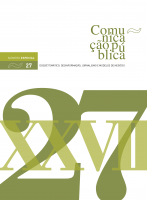From print journalism to the digital model
the New York Times’s transition process
DOI:
https://doi.org/10.4000/cp.5048Keywords:
journalism, New York Times, digital business paradigmAbstract
This paper aimed to analyze the transition process faced by The New York Times to achieve its digital business paradigm, which has specific aspects, responsible for making its adaptation to the Web 2.0 possible and also profitable. This study matters because of the newspaper’s tradition, as it exists since 1851, founded by Henry R. Raymond. Nowadays, the NYT gives a step further because it seeks for highlighting at the digital content production and, as a consequence, has the purpose of attracting new digital subscribers. So, this article tries to understand which strategies have been adopted by this newspaper to face the journalism crisis worldwide, reinventing itself in the digital scene.
Downloads
References
Costa, C. T. (2014). Um modelo de negócio para o jornalismo digital. Disponível em: http://www.omercadodenoticias.com.br/wp-content/uploads/um-modelo-de-negocio-para-jornalismo-digital_caio_tulio_costa.pdf. [Consult. em: 4 de setembro de 2018].
Costa, C. T. (2015). 6 pillars of a revenue-generating business model for digital journalism. Disponível em: https://www.inma.org/blogs/keynote/post.cfm/6-pillars-of-a-revenue-generating-business-model-for-digital-journalism#ixzz3avNd1NIp[Consult. em 29 de agosto de 2018].
Fechine, Y. & Figueirôa, A. (2011). Transmidiação: explorações conceituais a partir da telenovela brasileira. In: LOPES, Maria Immacolata Vassalo de (Org.). Ficção televisiva transmidiática no Brasil: plataforma, convergências, comunidades virtuais. Porto Alegre, Brasil: Sulinasm p.17-59.
Grueskin, B., Seave, A & Graves, L. (2011). Chapter four: The new media. Disponível em: https://archives.cjr.org/the_business_of_digital_journalism/chapter_four_the_new_new_media.php[Consult. em 29 de agosto de 2018].
Jenkins, J. (2014). The prosumption presumption. Disponível em: http://henryjenkins.org/2014/01/the-prosumption-presumption.html [Consult. em 30 de agosto de 2018].
Molina, M. (2008). Os melhores jornais do mundo - uma visão da imprensa internacional. São Paulo, Brasil: Globo.
Munday, R. (2018). New York Times: Conception Series. Disponível em: https://www.shortoftheweek.com/news/new-york-times-conception-series/ [Consult. em 29 de agosto de 2018].
NYTCO. (2006). 2005 annual Report. Disponível em: http://www.nytco.com/investors/financials/annual_reports _2005.html [Consult. em 29 de agosto de 2018].
NYTCO. (2005). 2004 annual report. Disponível em: http://www.nytco.com/investors/financials/annual_reports_2004.html [Consult. em 29 de agosto de 2018].
NYTCO. (2017). The New York Times company 2017 annual report. Disponível em: http://www.annualreports.com/HostedData/AnnualReportArchive/n/NYSE_NYT_2017.pdf [Consult. em 20 de agosto de 2019].
NYTCO. (2018). 2018 Diversity and inclusion report. Disponível em: https://www.nytco.com/company/diversity-and-inclusion/2018-diversity-inclusion-report/ [Consult. em 13 de agosto de 2019].
NYTCO. (2018). The year in numbers: 2018. Disponível em: https://www.nytco.com/the-year-in-numbers-2018/ [Consult. em 13 de agosto de 2019].
Saliba, R. (2016). A construção do jornalismo audiovisual na web: um olhar sobre o New York Times e o Buzzfeed. Disponível em: http://www.repositorio.jesuita.org.br/handle/UNISINOS/5443 [Consult. em 29 de agosto de 2019].
Talese, G. (2000). O reino e o poder: uma história do New York Times. São Paulo, Brasil: Companhia das Letras.
Thubron, R. (2018). New York Times CEO says print edition of paper could end in ten years. Disponível em: https://www.techspot.com/news/73274-new-york-times-ceo-print-edition-paper-could.html [Consult. em 30 de agosto de 2019].
Watté, B. (2003). O modelo de negócios do The New York Times na era da internet: uma referência para a indústria de jornais / Bruno Henriques Watté. Belo Horizonte, Brasil: 2013.
Downloads
Published
Issue
Section
License
Copyright (c) 2019 Direitos do Autor (c) 2019

This work is licensed under a Creative Commons Attribution-NonCommercial 4.0 International License.
Os conteúdos da Comunicação Pública estão licenciados com uma licença Creative Commons - Atribuição-NãoComercial 4.0 Internacional.


